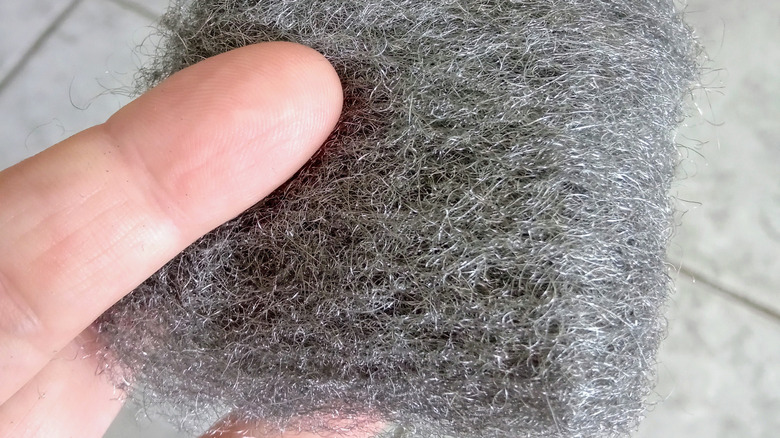This Rusty Steel Wool Hack Could Help Your Plants Thrive. Here's Why
Raising plants in and around your home can be rewarding as you watch them grow and add a sense of natural beauty to your surroundings. Helping them to thrive is a requirement that will only pay dividends in the visual aesthetic they have to offer. Providing them with light, water, and nutrients are just the basics they need to survive. Some plants require additional care like pruning or repotting, but nevertheless, making sure they are well nourished is a top priority. Knowing how much fertilizer to give each plant and when can leave you scratching your head. While these details shouldn't be overlooked, one easy way to help give your plants a nutrient boost is to create your own steel wool syrup from a product you likely already have at home.
Creating your own steel wool syrup is a super easy hack that upcycles a tool you would have just thrown away while simultaneously providing your plants with important nutrients they need to flourish. Steel wool contains iron, a micronutrient that plants rely on for creating chlorophyll. The iron leaches out by soaking rusty steel wool in water, forming a nutrient-dense drink for your plants. In this way, steeping your steel wool in water is an excellent way to create a cost-effective and environmentally friendly alternative to commercial fertilizers that will help your plants receive the iron supplements they need to develop healthy foliage.
Applying steel wool syrup to your plants
Creating your own steel wool syrup to provide your plants with a healthy iron substitute couldn't be simpler. All you need to get started is a used steel wool scrubber, a small container, and some fresh water. For an added boost, consider using rainwater as it contains nitrates, which will also help your plants thrive and develop lush foliage. If collecting rainwater isn't possible, then using tap is just fine. Fill the small container with water and then drop in your steel wool scrubber. Fully submerge it using a utensil or your fingers and give it a swirl to help release some of the iron. Do be sure that your steel wool isn't coated with any chemicals by removing the product label. These chemicals could potentially harm your plants.
Allow the scrubber to steep in the water until the water has turned a deep brown or gray color — the rusty iron from the steel wool will change the color of the water as it leaches out. This may take a few hours, so you'll need to be patient. As the scrubber steeps, you can continue to agitate it by swirling the container or using your fingers to massage the steel wool, releasing additional iron into the water. Once you're satisfied with the steel wool tea, you can remove the scrubber and discard it. Then use the syrup to water your plants, applying it around the base and avoiding any foliage.
Cautions for using this method
While using a rusty steel wool scrubber to create a nutrient-rich drink for plants may help your plants thrive, it's important to only use this method for ornamental plants. The steel wool you steep in the water may contain other harmful contaminants, including heavy metals or other potentially toxic compounds that you should avoid ingesting. Though consuming rust isn't considered outright dangerous or harmful, it's not recommended to do so either. Moreover, depending on what you've washed with the steel wool before using it to create a steel wool syrup, any surface it has previously touched could contaminate the syrup and, therefore, the plants and you.
Something else to keep in mind is that steel wool is often coated to prevent it from oxidizing and becoming rusty right away. Moreover, the steel utilized to create wool scrubbers can also be an alloy, meaning it's mixed with other metals such as chromium, nickel, or zinc. Any of these metals or coatings can leach into the solution along with iron, potentially reaching toxic levels for your plants. As a result, these metals can accumulate in the soil over time, leading to soil pollution and inadvertently causing adverse effects on your plants' growth and development. Finally, you shouldn't repeat this steel wool method too often, or the iron can accumulate in the soil, leading to iron toxicity, and it will actually cause your plants to wither and die instead of thrive.

